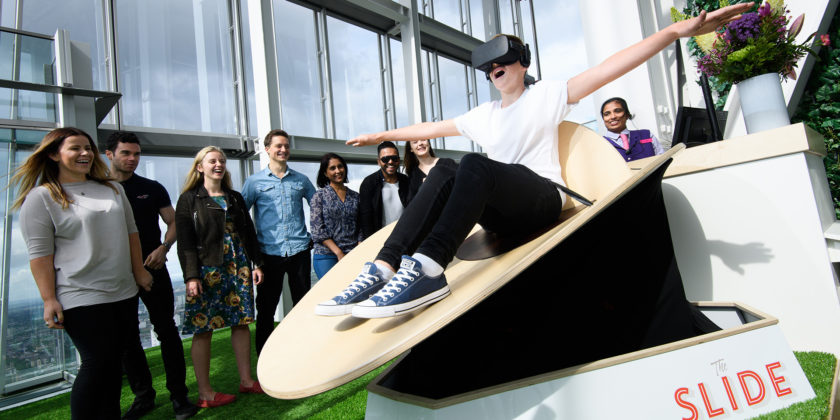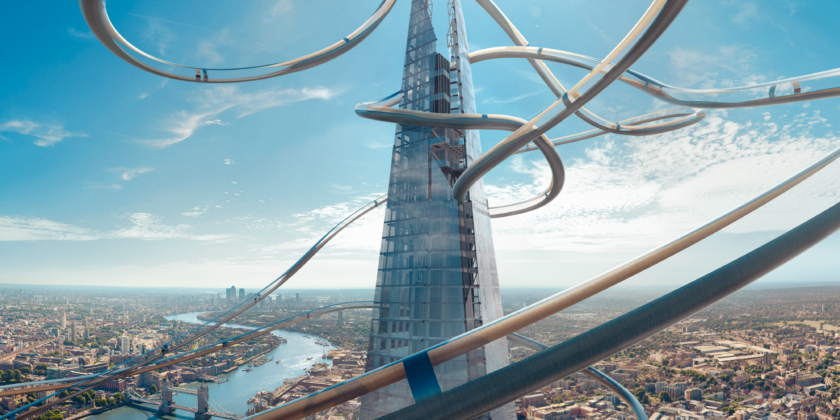Happy Finish: Building the tallest VR slide experience in the world
Describing itself as a “ground-breaking studio blending art with technology to entertain and engage”, Happy Finish is certainly entertaining, engaging and wowing the crowds at the UK’s highest building, The Shard in London, right now. Offering visitors to the 72-storey high viewing platform The View from The Shard the chance to slide down a virtual reality slide OUTSIDE of the building, the attraction is the tallest VR slide experience in the world.
What is it?
Working with London’s stunning skyline and an 800ft drop from the top of The Shard’s open air viewing deck to the ground, Happy Finish’s Chief Interactive Officer Daniel Cheetham said the virtual reality technology they used gave them the chance to immerse audiences in experiences that once would only have been available in the imagination. “With the Slide we directly evoke fear, joy and exhilaration equally by making people believe they are truly sliding out of the Shard on an adrenaline-fuelled ride.”
How has it been created?
To create the fast-moving free-fall experience alongside the dramatic views, the team used a responsive motion simulator along with photorealistic VR visuals. Happy Finish’s CG Team created a 3D replica of the viewing deck to create the visuals, from where the users start off on their journey. From there it’s a 100mph drop in a glass-sided CG slide that winds its way around a CG replica of the outside of the building, allowing the user to view The Shard from all angles as well as enjoy the panoramic views of London below.
The Happy Finish team worked with rigging partner Extreme Facilities to create the ‘virtual view’ from a high resolution 360-degree image, building a unique extending jib and custom camera rig to shout four 360-degree images at each corner of the 800ft high Skydeck. The images were then stitched together and went through extensive retouching and post production to produce the high spec finished result, experienced by the user though an Oculus Rift headset.
To amplify the visual effect with realistic movement, a custom-built motion platform has been integrated to match the movement of the VR content. It’s fast paced and furious, the machinery used allowed the Happy Finish developers to test 20-degree tilts and 60-degree movement in under a second.
Timeline, reviews and challenges
The slide was originally commissioned as a proof of concept project and turned around in a very speedy eight weeks. “Ideally we would have 10 to 12 weeks on a project like this,” Daniel explains. “But this just shows what can be done in a short time scale.”
It was also originally commissioned as a one-off piece for a short trial but six months later it’s proved so popular with visitors to the Shard’s viewing platform that it’s still in place. And those visitors have been impressed, with the majority of those who reviewed it on Trip Advisor giving it an ‘Excellent’ rating, with comments including ‘the VR slide is amazing’.
With timing being one of the main challenges for the team, creating the experience in a very short time frame for this degree of immersion, other challenges included the logistics and testing around ensuring the ride itself was not only a great experience, but that due diligence went into ensuring it was safe for all users.
Happy Finish: team and projects
Starting out as a retouching and CGI studio, the company has now expanded to include AR/VR/MR projects, animation and motion VFX, as well as Artificial Intelligence which is big forward driver for them Daniel reveals. And with a team of 110 people in three locations around the world – UK, US and India – most of their skillsets are employed in-house but they can bring in specialisms when needed, such as in the area of audio engineering and soundscapes.
As well as CG artists, that team now includes 360 video experts, as well as development and creative teams. “In the last 18 months we have focused more on big destination experiences,” says Daniel, with recent work including both branded content for organisations such as the Tate and as experiential content for Skoda. They have also worked with the likes of Prada, Google, Lufthansa and Guinness and offer their clients access to a network of talent in the fields of film, photography, art direction, CGI, illustration and special effects.
Other recent Happy Finish projects include the much talked about immersive tech-theatre experience, Somnai, which opened in London at the beginning of March. Happy Finish produced multiple dream-themed VR experiences for Somnai, dubbed as the first ever ‘layered reality’ theatre experience that’s paving the way for a whole new genre of entertainment.
This is not the first time Happy Finish have integrated virtual reality in the theatre world. Last year, Daniel and his team collaborated with immersive theatre duo AΦE on their hugely successful VR and AR-infused production WHIST, which is currently still enjoying global success on its world tour.

What does the future look like?
Data, says Daniel, will be used in the future to create stories and to inform design decisions.” With the expansion of data growing exponentially, that is an exciting prospect for this sector. Global market intelligence and services agency for IT and consumer tech, IDC, predicts that the world data will see a tenfold increase in the next few years, ramping up from 16 zettabytes today to 163 zettabytes by 2025 – with a zettabyte being one trillion gigabytes. Data is going to be used everywhere from improving traffic flows to growing food.
With millions of digital consumers looking to consume content in the entertainment sector, media companies and studios are in a unique position to leverage big data assets for improved customer engagement, in terms of predicting what audiences want, increasing acquisition and engagement, as well as developing new targeted content.
Artificial Intelligence will be another big player in this space. Speaking about the team’s recent project with the Royal Academy of Art, Head of Technology and AI aficionado Marco Marchesi explains that advancements in AI are contributing to creative developments, with Style Transfer techniques pushing this forward.
“We’ve successfully incorporated pioneering Style Transfer techniques into our CG and VFX pipeline and recently created a pretty cool VR experience for the Royal Academy, in a coloration with renowned artist Yinka Shonibare.”
The experience allows viewers in the gallery to ‘step into’ a 3D version of an 18th century Neoclassical painting by Gavin Hamilton and explore the world created inside it, from an elegant room setting right out into a courtyard where Yinka has created a contemporary VR statue. Read more about the project here
“Artificial intelligence is big on the agenda for us,” reveals Daniel. “We’re incorporating it into developing more creative experiences for audiences and looking at how we can leverage machines to create experiences and content. This will all affect how we make things in the future.”
Words by Bernadette Fallon
